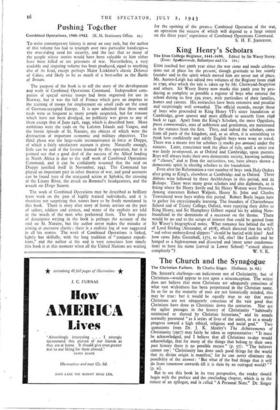Combined Operations, 1940-1942. (H. M. Stationery Office. Is.)
Pushing Together
To write contemporary history is never an easy task, but the author of this volume has had to triumph over two particular handicaps-k- the over-riding need for security, and the fact that so many of the people whose stories would have been valuable to him either have been killed or are prisoners of war. Nevertheless, a very readable and inspiring volume has been produced, equal to anything else of its kind, except perhaps Major LinkLater's classic Defence of Calais, and likely to be as much of a best-seller as the Battle of Britain.
The purpose of the book is to tell the story of the development and work of Combined Operations Command. Independent com- panies of special service troops had been organised for use in Norway, but it was the fall of France which gave an impetus to the training of troops for employment on small raids on the coast of German-occupied Europe. It is now admitted that these small raids were as frequent as many people suspected, but for reasons which have not been divulged, no publicity was given to any of them except that of June 24th, 1940, which is described here. More ambitious were the raids on the Lofoten Islands and Vaagso, and the heroic episode of St. Nazaire, the objects of which were the destruction of important economic and military objectives. The third phase was the large-scale reconnaissance in force at Dieppe, of which a fairly satisfactory account is given. Naturally enough, little can be said of the lessons learned by this operation, but it is pointed out that a good deal of the success of the Allied landing in North Africa is due to the staff work of Combined Operations Command, and it can be confidently assumed that the raid on Dieppe justified itself in November, 1942. The Command has played an important part in other theatres of war, and good accounts can be found here of the rearguard action at Sphakia, the crossing of the Litany River, the attack on Rommel's headquarters, and the assault on Diego Suarez.
The work of Combined Operations may be described as brilliant team work on the part of highly trained individuals, and it is therefore not surprising that names have to be freely mentioned in this book. There is story after story of heroic actions on the part of sailors, soldiers and airmen, and many of the exploits are told in the words of the men who performed them. The best piece of descriptive writing in the book is pirhaps the account of the raid on St. Nazaire, but the author never makes the mistake of aiming at excessive clarity ; there is a realistic fog of war suggested in all his stories. The work of Combined Operations is linked, lightly but skilfully, with the long tradition of " conjunct expedi- tions," and the author at the end is very conscious how timely this book is at this moment when all the United Nations are waiting for the opening of the greatest Combined Operation of the war, an operation the success of which will depend to a large extent on the three years' experience of Combined Operations Command.
S. H. F. JOHNSTON.


























 Previous page
Previous page